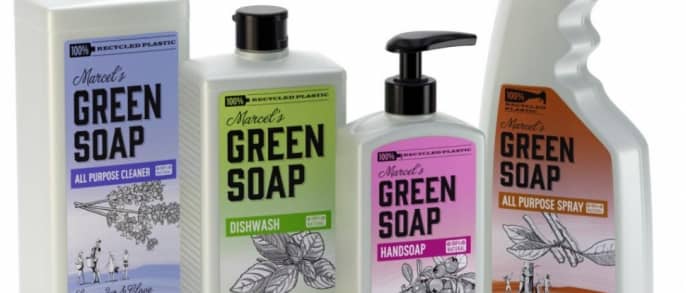Cosmetics and soap
The cosmetics and soap industries use a wide range of packaging. Cosmetic packaging, for instance, includes packaging for personal care products such as shampoo, toothpaste, deodorant, sun cosmetics, makeup, and perfume. The soap industry sells many different washing, cleaning, maintenance, and disinfectant products, such as dishwasher detergents, fabric softeners, and all-purpose cleaners. The most commonly used packaging material is plastic. Important considerations in packaging designs for both industries are dosage, usage, and safety instructions, material selection, and optimal product protection during transport and storage.
Trends and challenges
The most important developments affecting packaging in the cosmetics and soap industries are:
- Using recycled materials in plastic packaging.
The use of recyclate in packaging reduces the need for virgin material. In the cosmetics and soap sector, there are many opportunities for applying plastic recyclate, because this packaging usually does not have to meet the requirements for food packaging. Commissioned by the KIDV, Tilburg University investigated the possible bottlenecks in legislation and regulations regarding the use of recycled plastic. Read more about the study here (only available in Dutch). The use of recycled PP and PE is developing rapidly. - Using biobasedand biodegradable packaging materials.
The use of biobased packaging materials is also seen in this sector. Paper and cardboard are well-known biobased packaging materials. There are different types of biobased plastics. The molecular structure of some of them is the same as that of fossil plastics. These bio-based plastics can be mixed with fossil plastics in recycling and have the same properties, such as melting temperature or air permeability. An example of this is bio-PE, which is made from sugar cane and is used in HDPE bottles, among other things.
There are also plastics made from renewable raw materials that have a different molecular structure than the conventional fossil plastics. They therefore have different properties. Some variants are, for instance, compostable or allow more oxygen to pass through, which makes them especially suitable for packaging certain fruit and vegetables. Examples are PLA and starch. PLA is used in trays and foils and starch in plastic bags.
Read more about biobased and compostable packaging here.
- Using refill packaging.KIDV has started a Community of Practice on Reusable Packaging in which the opportunities and challenges of reusable packaging are discussed. Planet Reuse is doing this at the European level.
- Marketing and packaging with a luxury appearance.
The marketing and image of cosmetics packaging often take precedence over the sustainability of the packaging. Stay critical whether this addition is really necessary and whether it can be done more sustainably. Also look for sustainability possibilities in other steps of the packaging chain, for example during transport. In addition, make sure that the packaging is easy to recycle, so that the materials can be reused in new products and packaging. You can use the KIDV Recyclecheck to assess whether the packaging is recyclable or not.
- Ambitions of governments and companies to introduce reusable and recyclable packaging.Packaging must comply with the applicable laws and regulations. In recent years, the European Commission and the Dutch government have introduced and adopted new proposals and are implementing action programmes, among other things to increase the recyclability and reuse of packaging and to reduce the amount of waste. Keep informed of these developments so that you can respond to future legislation in a timely manner and so that your company can distinguish itself from other companies as a frontrunner in the field of sustainability. KIDV keeps an overview here (only available in Dutch) of the changes in legislation and regulations, such as the new recycling targets, changes to the essential requirements for packaging and the approach to single-use plastics.
Getting started with sustainable packaging
Anyone who starts working with sustainable packaging will often quickly discover that there is more to it than just using less or different material. To develop successful sustainable packaging, you have to look at the packaging process and logistics, at customers’ purchasing and disposal behaviour, and at your company’s packaging and sustainability strategy. For more information and tips, visit KIDV Five Perspectives on Sustainable Packaging.
The Dutch Association for Cosmetics (Nederlandse Cosmetica Vereniging, NCV) and the Dutch Association of Soap Manufacturers (Nederlandse Vereniging van Zeepfabrikanten, NVZ) have each written a 2019-2022 Sector Innovation Plan for Sustainable Packaging. In this plan, they set out ambitions, objectives, and concrete measures to reduce the environmental impact of packaging, focusing primarily on the key sustainability themes of rethink, reduce, resource, and recycle.
The KIDV has conducted a detailed study on packaging of frequently sold soaps and detergents as well as on packaging of frequently sold cosmetics. These studies - under the name Verpakkingsbarometer - show companies where the most profit can be made to make their packaging more sustainable. The studies are only available in Dutch.





